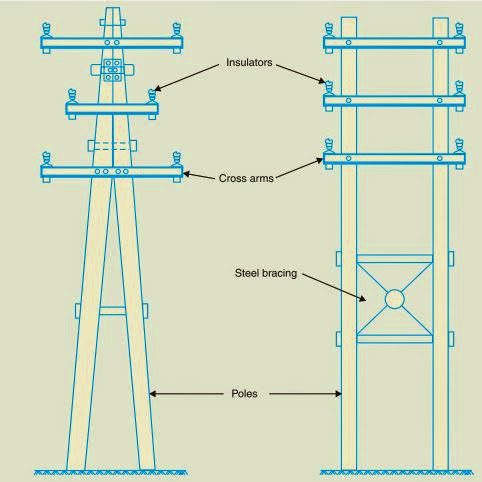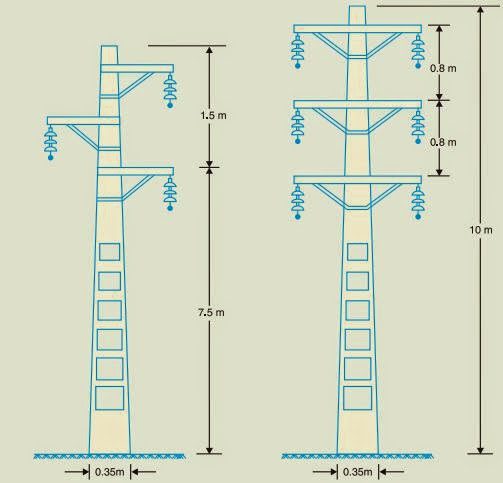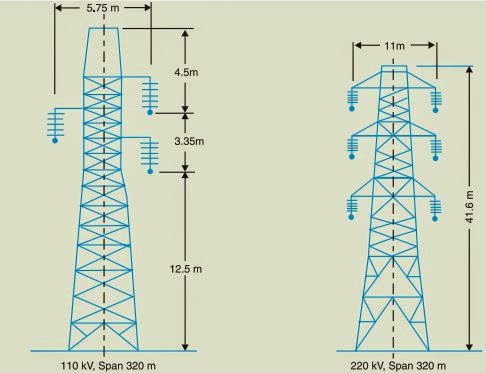Types of Electric poles:
Let us discuss the types of electric poles used in overhead transmission lines. The supporting structures for overhead line conductors are various types of poles and towers called line supports. In general, the line supports should have the following properties :
- High mechanical strength to withstand the weight of conductors and wind loads etc.
- Light in weight without the loss of mechanical strength.
- Cheap in cost and economical to maintain.
- Longer life.
- Easy accessibility of conductors for maintenance.
The line supports used for transmission and distribution of electric power are of various types including
- wooden poles
- steel poles
- RCC poles
- lattice steel towers
The choice of supporting structure for a particular case depends upon the line-span, X-sectional area, line voltage, cost and local conditions.
1. Wooden poles: These are made of seasoned wood (sal or chir) and are suitable for lines of the moderate X-sectional area and of relatively shorter spans, say up to 50 meters. Such supports are cheap, easily available, provide insulating properties and, therefore, are widely used for distribution purposes in rural areas as an economic proposition. The wooden poles generally tend to rot below the ground level, causing foundation failure.
In order to prevent this, the portion of the pole below the ground level is impregnated with preservative compounds like creosote oil. Double pole structures of the ‘A’ or ‘H’ type are often used to obtain a higher transverse strength that could be economically provided by means of single poles.
Get your industrial equipment from ejawda.com
The main objections to wooden supports are :
(i) the tendency to rot below the ground level
(ii) comparatively smaller life (20-25 years)
(iii) cannot be used for voltages higher than 20 kV
(iv) less mechanical strength and
(v) require periodical inspection.

2. Steel poles: The steel poles are often used as a substitute for wooden poles. They possess greater mechanical strength, longer life and permit longer spans to be used. Such poles are generally used for distribution purposes in the cities. This type of support needs to be galvanized or painted in order to prolong its life. The steel poles are of three types (i) rail poles (ii) tubular poles and (iii) rolled steel joints.
3. RCC poles: The reinforced concrete poles have become very popular as line supports in recent years. They have greater mechanical strength, longer life and permit longer spans than steel poles. Moreover, they give a good outlook, require little maintenance and have good insulating properties. The figure shows RCC poles for the single and double circuit.
The holes in the poles facilitate the climbing of poles and at the same time reduce the weight of line supports. The main difficulty with the use of these types of electric poles is the high cost of transport owing to their heavyweight. Therefore, such poles are often manufactured at the site in order to avoid the heavy cost of transportation.

4. Steel towers: In practice, wooden, steel and reinforced concrete poles are used for distribution purposes at low voltages, say up to 11 kV. However, for long-distance transmission at higher voltage, steel towers are invariably employed. Steel towers have greater mechanical strength, longer life, can withstand most severe climatic conditions and permit the use of longer spans.
The risk of interrupted service due to broken or punctured insulation is considerably reduced owing to longer spans. Tower footings are usually grounded by driving rods into the earth. This minimizes the lightning troubles as each tower acts as a lightning conductor.
The figure below shows a single circuit tower. However, at a moderate additional cost, the double-circuit tower can be provided as shown in Figure below. The double circuit has the advantage that it ensures continuity of supply. In case there is a breakdown of one circuit, the continuity of supply can be maintained by the other circuit.

Now, while we’ve covered the different types of electric poles used in overhead transmission lines, it’s worth considering the importance of protecting your electrical equipment, such as aquarium setups, from power surges. If you’re an aquarium enthusiast seeking to safeguard your aquatic environment, finding the best power strip for aquarium setups becomes crucial. Ensure the safety of your valuable equipment by exploring power strips that offer surge protection and convenience, specifically designed for aquarium setups.
Conclusion:
We have discussed types of electric poles in transmission lines.
Comment below for any queries.
In my opinion, the height of the pole depends on the public conditions especially the trucks and cars which may cause the damage to the cable .
I want to know completely about electric poles such as its desired properties, how the height of the pole are decided, the distance between the poles to be calculated etc.., . Can you suggest me or share some material you poses so it can be helpful for my thesis?
what is distance between two RCC poles ?? sir
As per distribution system , it is 50 meters but it depends upon the location they lay the poles like if the ground is muddy or hilly etc..
We can't fix to one number.
In general, the distance between two RCC poles is typically in the range of 10-20 meters, but it can vary depending on the specific requirements of the project.
This is very good article which has in detail information regarding Types of electric poles in overhead transmission lines. This is also a good blog on electrical-engineering. I am very glad to read this article